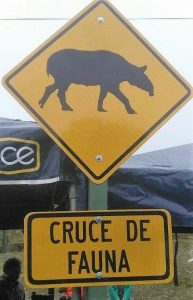
MINAE
Several public institutions, communities and the Nai Conservation organization came together to set up road signs and launch a campaign to prevent tapirs from dying on the road.
The signs were placed on the South Interamerican Highway.
The passage of vehicles by this route is the greatest threat to the tapirs, specifically in the area of Cerro de la Muerte (kilometer 62 to 98). In the last 7 years, 23 abuses have been reported.
The road crosses several protected areas, such as the Tapantí-Macizo de la Muerte National Park, Los Quetzales National Park, Las Vueltas Biological Reserve and Rio Macho Forest Reserve.
The signals will be placed along 32 kilometers, at points identified from the data generated by the research work of the Nai Conservation team.
The ministries of Public Works and Transport and the Environment (MINAE), along with the National System of Conservation Areas (SINAC) participated in this Wednesday’s activity. In addition, there were researchers, universities, schools and neighbors of the surrounding communities.
MINAE stressed that signage is the result of inter-institutional work in conjunction with local communities, to mitigate the high incidence of tapir deaths in the area.
The Central American tapir (Tapirus bairdii) is the largest terrestrial neotropical mammal, with an average weight of 285 kilograms. It is currently listed in Appendix 1 of the Convention on International Trade of Endangered Species of Wild Fauna and Flora, where the most endangered species are found.
It is also endangered according to the International Union for Conservation of Nature (IUCN).